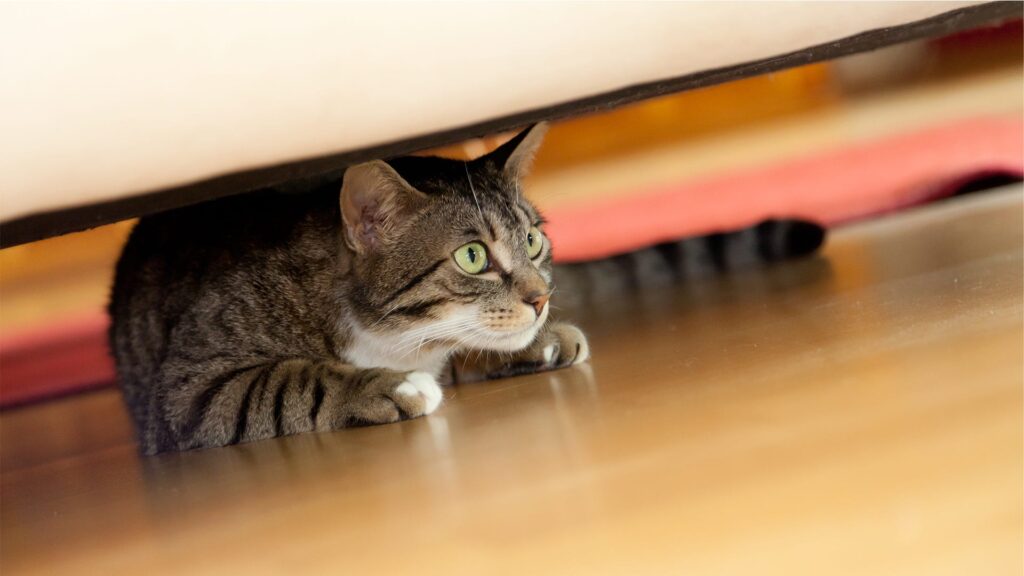Let your kitten roam the house after it is at least four months old and has been properly trained. In the early weeks, confine the kitten to a smaller space, gradually giving it more freedom as it grows.
Contents
- 1 Why It’s Important To Allow Your Kitten To Explore
- 2 Preparing Your Home For Your Kitten To Roam
- 3 Gradually Introducing Your Kitten To Each Room
- 4 Supervising Your Kitten During Roaming Time
- 5 Understanding Your Kitten’s Body Language And Signals
- 6 Establishing A Routine For Your Kitten’s Roaming Time
- 7 Introducing Other Pets To Your Kitten During Roaming Time
- 8 Tips For Encouraging Proper Litter Box Usage
- 9 Encouraging Positive Behavior During Roaming Time
- 10 Gradually Expanding Your Kitten’s Access To The Whole House
- 11 Frequently Asked Questions On When Should I Let My Kitten Roam The House: Tips And Tricks
- 12 Conclusion
Why It’s Important To Allow Your Kitten To Explore
Allowing your kitten to explore is essential for its development. Kittens have natural instincts of curiosity and exploration, and giving them the opportunity to roam the house can satisfy these instincts. It promotes socialization and confidence as they interact with different environments, objects, and people.
Exploring the house helps kittens become familiar with their surroundings and build their spatial awareness. It allows them to learn to navigate and find safe hiding spots when needed. By exploring, kittens also develop their problem-solving skills as they encounter different situations and obstacles throughout the house.
Furthermore, allowing your kitten to explore can help prevent behavior problems. When kittens are confined to a specific area for too long, they can become bored, restless, and even develop destructive behaviors. Exploring provides mental stimulation and helps keep them physically active, which is essential for their overall well-being.
Remember to kitten-proof your house by removing any potential hazards, such as toxic plants or small objects that can be swallowed. Supervising your kitten during its exploration is also important to ensure its safety. Gradually increase the areas your kitten can access as it grows older and more comfortable with its surroundings.

Credit: www.comfortzone.com
Preparing Your Home For Your Kitten To Roam
It’s an exciting time when you decide to let your kitten roam the house! However, before that happens, it’s important to prepare your home to ensure a safe environment for your furry friend. The first step is creating a safe and kitten-friendly environment. This involves removing any hazards and potential dangers that could harm your curious kitten.
| Hazards to Remove | Safety Measures |
|---|---|
| Electrical cords | Hide or cover cords to prevent chewing |
| Chemicals and cleaning products | Store them out of reach in locked cabinets |
| Houseplants | Remove toxic plants and place safer alternatives |
| Fragile items | Secure breakables or store them away |
| Small objects | Pick up small items that can be swallowed |
By taking these precautions, you can create a safer environment for your kitten to explore. Remember to supervise your kitten initially and gradually increase their access to the different areas of your home. With a safe and kitten-friendly environment, both you and your furry friend can enjoy the freedom of letting them roam the house.
Gradually Introducing Your Kitten To Each Room
Gradually Introducing Your Kitten to Each RoomOne of the most important parts of raising a kitten is properly introducing them to their new home. Starting with a small, confined area is recommended, such as a bathroom or a spare room. This allows them to adjust and feel safe in a limited space. Make sure this area has all the essentials, including food, water, a litter box, and a cozy bed.
As your kitten gets more comfortable in their confined space, you can slowly expand their access to other rooms. Slowly expanding their access as they become more familiar with the initial area helps them feel in control of their environment. Open the door and let your kitten explore at their own pace.
Remember to supervise your kitten during these explorations to ensure their safety. Remove any potential hazards or fragile items that they may knock over. Creating a welcoming environment with hiding spots and vertical furniture, like cat trees or shelves, can also provide a sense of security for your kitten.
By gradually introducing your kitten to each room, you are giving them the opportunity to explore and become familiar with their new surroundings at their own pace. This process helps in building confidence and ensures a smooth transition into their new home.
Supervising Your Kitten During Roaming Time
Supervising your kitten during roaming time is essential to ensure their safety and well-being. Keep an eye on their behavior and activities to identify any potential risks or signs of trouble. Kittens are naturally curious and may explore dangerous or restricted areas of the house. Regularly check for any objects, chemicals, or small items that could be harmful if ingested. Secure electrical cords and keep breakable items out of reach. Providing your kitten with plenty of toys, scratching posts, and climbing structures can help divert their attention from potential hazards. If needed, consider setting up a confined space equipped with food, water, and a litter box, especially when you cannot closely supervise them. Gradually increase their roaming time as they grow older and demonstrate responsible behavior. By implementing these precautions, you can ensure your kitten’s safety while allowing them the freedom to explore their environment.
Understanding Your Kitten’s Body Language And Signals
Understanding your kitten’s body language and signals is crucial when it comes to their well-being and allowing them to roam the house. Recognizing signs of anxiety or stress is the first step in providing a safe and comfortable environment for your furry friend.
Kittens may display various signs of distress such as excessive meowing, pacing, hiding, or aggression. If you notice any of these behaviors, it’s important to respond appropriately to their needs. Providing them with a quiet and secure space, offering toys and interactive playtime, and establishing a consistent routine can help alleviate their anxiety.
Additionally, be mindful of their physical cues, including flattened ears, dilated pupils, or a tucked tail, which may indicate fear or discomfort. Creating a peaceful atmosphere and maintaining a calm demeanor yourself can provide reassurance to your kitten.
By understanding and responding to your kitten’s body language and signals, you can gradually introduce them to different areas of the house, ensuring their safety and well-being as they explore their surroundings.
Establishing A Routine For Your Kitten’s Roaming Time
Establishing a routine for your kitten’s roaming time is essential to ensure their safety and well-being. Start by setting a schedule for supervised play and exploration. This will help them become familiar with their surroundings gradually and prevent any accidents or injuries. Let your kitten roam the house in short periods initially, gradually increasing the duration as they get older and more familiar with the environment. Be sure to supervise their roaming time to prevent them from getting into any hazardous situations or damaging furniture.
It is also important to balance their roaming time with rest and quiet time. Provide a designated area for them to relax and rest, such as a cozy bed or a comfortable cat tree. This will help them establish a routine and understand when it’s time to play and explore, and when it’s time to rest and recharge. By establishing a routine for your kitten’s roaming time, you can ensure they have a safe and enjoyable environment to grow and thrive in.
Introducing Other Pets To Your Kitten During Roaming Time
Introducing your kitten to other pets during roaming time requires careful planning and preparation to ensure a positive and safe environment for all animals involved. Slow and supervised introductions are essential to allow for proper socialization and prevent any potential conflicts.
Start by creating a separate space for your kitten to roam freely, such as a designated room or area, where they can establish their own territory. This will help them feel secure and reduce the likelihood of territorial disputes with existing pets. Gradually introduce them to other pets through controlled interactions, such as supervised play sessions or short meet-and-greets.
During these introductions, always watch for any signs of aggression or distress from either your kitten or existing pets. If tensions arise, separate the animals and try again at a later time. Provide plenty of positive reinforcement and treats for good behavior to encourage a harmonious relationship between all pets.
Tips For Encouraging Proper Litter Box Usage
Placing the litter boxes in accessible areas is essential for encouraging your kitten to use it consistently. Make sure to provide one litter box per cat and position them in quiet and private corners of your house. Avoid placing them next to loud appliances or in areas with high foot traffic as this may discourage your kitten from using the litter box. Consistent cleaning and maintenance are also crucial to promote proper litter box usage. Cats are clean animals, and a dirty litter box can be a major deterrent. Scoop the litter box daily and completely change the litter on a regular basis. Keeping the litter box clean and fresh will help reinforce the positive habit. By following these tips, you can ensure that your kitten learns the appropriate behavior and uses the litter box consistently.
Encouraging Positive Behavior During Roaming Time
When allowing your kitten to roam the house, it’s important to encourage positive behavior to create a safe and happy environment. Using toys, treats, and positive reinforcement can be highly effective in redirecting unwanted behaviors. Interactive toys such as feather wands or puzzle toys can keep your kitten engaged and mentally stimulated. Additionally, providing scratching posts and climbing trees can help satisfy their natural instincts. Offering treats as rewards for good behavior can reinforce positive actions. Positive reinforcement, such as petting or praising your kitten when they exhibit desired behavior, can be a powerful tool in shaping their actions. It’s crucial to redirect unwanted behaviors by discouraging them with a gentle spray of water or a loud noise while simultaneously redirecting their attention to an appropriate toy or scratching post. By consistently using these techniques, you can encourage positive behavior during roaming time and create a harmonious environment for your kitten.
Gradually Expanding Your Kitten’s Access To The Whole House
Gradually Expanding Your Kitten’s Access to the Whole House
- When bringing home a new kitten, confining them to a small space initially, such as a single room or a playpen, can help them feel safe and secure.
- Observe their behavior and ensure they are comfortable in their restricted area before slowly allowing them access to more rooms in the house.
- Take note of their reactions to each new space and pay attention to any signs of stress or anxiety.
- If your kitten shows signs of being overwhelmed, it’s important to give them more time to adjust and gradually introduce new areas.
- As your kitten grows and adapts, start giving them supervised access to additional rooms, allowing them to explore and gradually gain more freedom.
- Ensure each room is kitten-proofed, removing any potential hazards or breakables to maintain their safety.
Giving your kitten the opportunity to gradually roam the entire house will help them feel comfortable and confident in their environment, promoting a stress-free and happy living experience for both you and your furry companion.
Frequently Asked Questions On When Should I Let My Kitten Roam The House: Tips And Tricks
When Can I Let A Kitten Roam The House?
You can let a kitten roam the house once they are around 12 weeks old and have received all necessary vaccinations. Always supervise them initially to ensure their safety and gradually introduce them to different areas of the house.
How Long Should I Keep My Kitten In One Room?
Keep your kitten in one room for about 1-2 weeks. It allows them to adjust, feel secure, and bond with you. Gradually introduce them to other areas of your home, ensuring their safety and monitoring their behavior. Offer plenty of love, attention, and playtime for a smooth transition.
How Do I Get My Kitten To Explore My House?
To get your kitten to explore your house, create a safe and inviting environment. Start with a dedicated room, and gradually introduce new areas as they become comfortable. Use toys and treats to entice exploration. Supervise to prevent any hazards, and give plenty of praise and positive reinforcement.
How Long Does It Take For A Kitten To Adjust To A Home?
It typically takes a kitten around 2-3 weeks to adjust to a new home. During this time, provide a safe environment, proper care, and plenty of love to help them feel comfortable and settle in.
Conclusion
Allowing your kitten to roam the house can be an exciting milestone in their development. By following these tips and tricks, you can ensure their safety while giving them the freedom to explore their surroundings. Remember to gradually introduce new areas, provide plenty of stimulation, and monitor their behavior for any signs of distress.
With time and patience, your kitten will become a confident and well-adjusted member of your household. Happy adventures!

Katie Lindsey is a passionate cat lover and founder of Cats Solution, a comprehensive resource for all things feline. With a lifelong love for cats and extensive knowledge in their care and behavior, she provides expert advice and solutions to cat owners. Through her website, Katie fosters a supportive community where cat enthusiasts can find guidance and heartwarming stories. A dedicated advocate for animal welfare, Katie also promotes responsible pet ownership and adoption. Join her on this purr-fect journey celebrating the joy of feline companionship.



